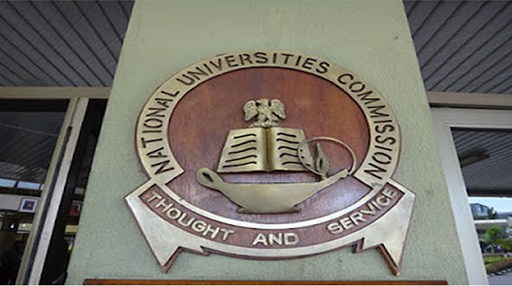
To project and position, companies do create strategic statements. These statements range from vision to mission and goals to objectives. Apart from projecting and positioning companies, these statements serve as carriers of ideologies and institutional cultures. Like other profit-making organisations, universities are also using phrases and sentences to communicate with the publics their purpose of existence and how they want to deliver value.
However, this piece is not about discussing the fundamentals of creating these statements. Instead, it focuses on the strategic evaluation of the statements (vision and mission) of the Nigerian oldest Universities. Our analyst considers this imperative based on the fact that institutions, like other businesses, are expected to modify their strategic statements as the business environment changes.
To get the needed insights about the Universities’ strategic statements, our analyst extracted the statements from the official websites. In the piece, the focus was on the University of Ibadan, the University of Nigeria, the University of Lagos, the University of Benin, the University of Calabar, the Obafemi Awolowo University, the Ahmadu Bellow University, the University of Ilorin and the University of Maiduguri. Examination of the statements indicates these Universities want the publics to understand their strategy, purpose, values, standards and expected behaviours of the students and when they must have graduated from the Universities.
Register for Tekedia Mini-MBA edition 19 (Feb 9 – May 2, 2026): big discounts for early bird.
Tekedia AI in Business Masterclass opens registrations.
Join Tekedia Capital Syndicate and co-invest in great global startups.
Register for Tekedia AI Lab: From Technical Design to Deployment (next edition begins Jan 24 2026).
Demystifying Strategic Statements: Our Measures and Data
Collective analysis of the Universities’ statements reveals that 283 and 240 words were used to construct mission and vision statements respectively. It also emerged that these Universities appropriated 223 unique words for the construction of mission statements, while it was 201 words for the development of vision statements [see Exhibit 2]. By unique words, the Universities were discovered to display their ability to choose different words [not repeating one word several times] in their construction of the statements.
On average, 208 words were used per sentence for mission statement development, while 204 words were employed for vision statements. Analysis further shows that vocabulary density of mission statements is 768%, while vision statements have 814%. The high percent for the vision statements signifies that the statements are not complex to understand. Despite this, the individual analysis reveals that the mission statement of Ahmadu Bello University is the most complex to understand. It has 10% vocabulary density. For the vision statements, the University of Ibadan, the University of Nigeria and the Obafemi Awolowo University are complex to understand because of lots of unique words. Our analyst’s expectation is that these Universities would employ words and reused them to strategically stress their [Universities] purposes, values, standards and the expected behaviours.
The Linkages and Public Interest
We explored connections among the strategic statements with the specific reference to selected indicators. Analysis establishes that the number of words in mission and vision statements are connected by 26.3%. Unique words in mission and vision are correlated by 2.5%, while it was 26.1% for vocabulary density. One of the most significant implications of these results is that there is 2.5% opportunity of seeing a unique word used in constructing mission statements in vision statements of the Universities. This is below expectation considering the need to use unique words less and reuse them to stress the purpose of existing and the kind of value the Universities wanted to offer their students and other stakeholders.
Overall, there is no strong difference between the construction of mission and vision statements of the Universities. On all the indicators, mission statements of the Universities are better than vision statements. In spite of this, analysis shows that the ways the vision statements are constructed have a tendency of contributing to playing the right and sustainable generic strategy choices.
Since these Universities are expected to research, teach students, innovate and help their immediate and global communities, our analyst examines global public interest in these areas and stakeholder [research, teaching, students, innovation and community] within the context of public searches using the Internet. We believe that public engaged in information seeking on the Internet to understand what Colleges and Universities globally can offer from 2015 to 2019. Trending analysis of the interest in these areas and stakeholder [students] shows that interest was high in students, research and community more than in teaching and innovation. These indicators [research, students, teaching, innovation and community] were used to construct Strategic Global Public Interest Index [SGPII]. Analysis reveals that the SGPII was high in 2015 and 2016 and low in 2017 to 2019. Out of the indicators used for the analysis of the statements [see earlier insights], the unique word formation was employed to understand the place of the Universities within the SGPII.
Looking at Exhibit 1, it is obvious that the contribution of the unique words was flat and in reverse curve trends between 2015 and 2019. In all, the use of unique words in vision statements has contributed significantly to global understanding of research, students, teaching, innovation and community within Colleges and Universities search category.
Exhibit 1: Prediction Trends of Mission and Vision Statements in Global Strategic Public Interest Index (2015-2019)
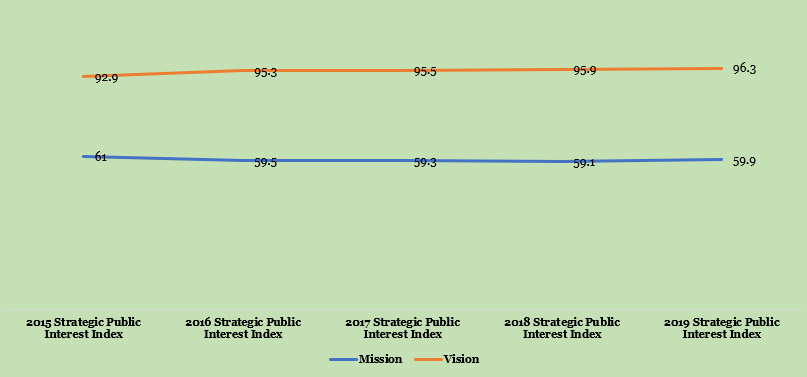
Exhibit 2: Average Performance per each indicator
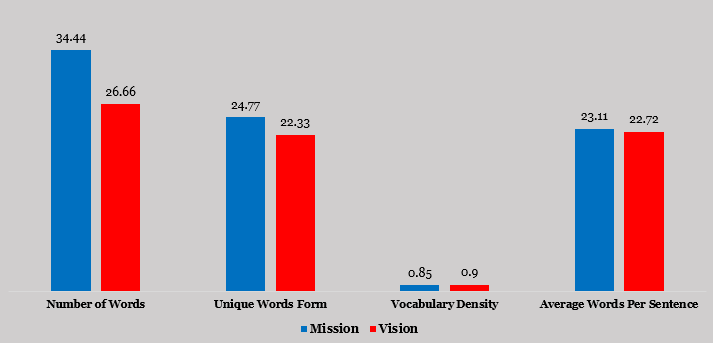
Playing Strategic Choice Games
According to our analysis, these Universities are pursing differentiation and focus strategies more than cost leadership strategy [see Exhibit 3]. Playing differentiation strategy means that the Universities are working on areas where they have the capabilities and resources to deliver sustainably. The focus strategy, on the other hand, represents the Universities’ concentration of their capabilities and resources to particular segments of the Nigerian and global societies [see individual analysis below]. Playing cost leadership is a matter of the Universities looking at how they can produce graduates, serve industries and communities with a low cost structure.
The data for cost leadership were gathered from various sources [see one of the sources] that indicates average and range of amounts collected as school fees between 2018 and 2019. Individual analysis shows that Ahmadu Bello University, University of Maiduguri, University of Calabar and University of Ilorin are playing cost leadership game. University of Ibadan is the only University that does not play focus strategy game when the vision statement is considered. In its mission statement, it emerged that it plays, while the University of Lagos and University of Nigeria do not play the game.
Exhibit 3: Generic Strategies of the Universities
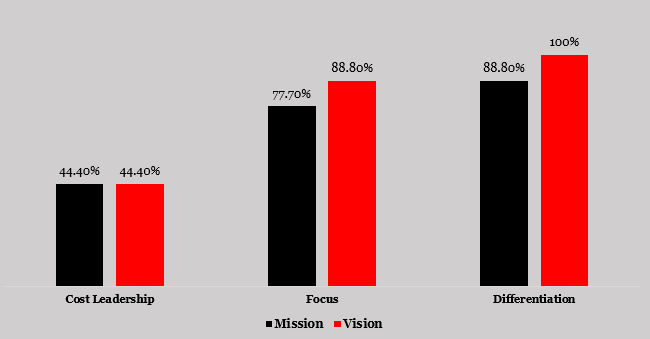
The Individual University
The University of Ibadan was established in 1948 as a University College affiliated with the University College London. This University’s mission is “to expand the frontiers of knowledge through provision of excellent conditions for learning and research. To produce graduates who are worthy in character and sound judgement. To contribute to the transformation of society through creativity and innovation. To serve as a dynamic custodian of society’s salutary values and thus sustain its integrity.” The vision is “to be a world-class institution for academic excellence geared towards meeting societal needs.”
Corpus analysis of the mission and vision indicates that the University tends towards producing graduates found worthy in character and learning without compromising their ability to innovate and advance the society. The University also believes in being the custodian of the country’s values and culture.
Exhibit 4: Link among the keywords in the University of Ibadan’s Mission Statement
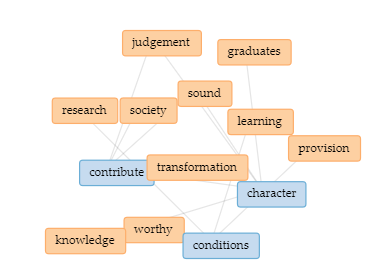
Exhibit 5: Link among the Keywords in the University of Ibadan’s Vision Statement
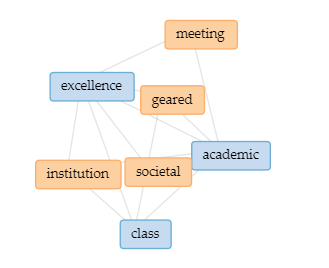
The University of Nigeria came into existence in 1955, making it the second oldest University after the University of Ibadan. Our check indicates that this University’s mission is “to attract, educate, train and transform qualified persons to high level manpower that are thoroughly equipped with adequate and update knowledge and specialized skills in research and innovation and deployable for first-rate development and improvement in all fields of human endeavour.” Achieving these means “becoming a globally reputed first-rate School of Postgraduate studies.” Analysing trends of the statements, we found that the University of Nigeria believes in gathering required and sufficient resources for production of its desired graduates and contribution to the society with the hope of being rated locally and internationally, especially as a University with the best postgraduate school.
Exhibit 6: Link among the keywords in the University of Nigeria’s Mission Statement
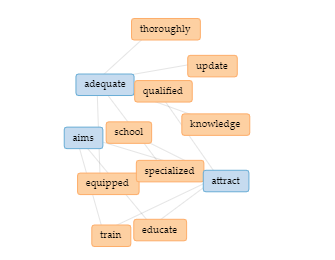
Exhibit 7: Link among the keywords in the University of Nigeria’s Vision Statement
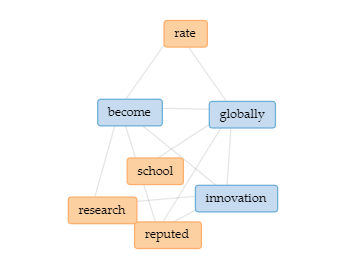
Looking at the years of establishing first generation universities in Nigeria, we also discovered that the establishment of University of Lagos in 1962 immediately follows the University of Nigeria. Like other universities, the University of Lagos’ mission is constructed as “to provide a conducive environment for teaching, learning, research and development, where staff and students will interact and compete effectively with other counterparts globally.” The vision is “to be a top-class institution for the pursuit of excellence in knowledge, character and service to humanity.”
Examination of these statements indicates that the University of Lagos believes in competing with others nationally and globally through deployment of resources effectively and efficiently. It also emerged that the University believes in having a conducive environment for teaching, learning and researching about academic and societal issues and needs. With these, students would be found worthy in character, learning and advancing the humanity.
Exhibit 8: Link among the keywords in the University of Lagos’ Mission Statement
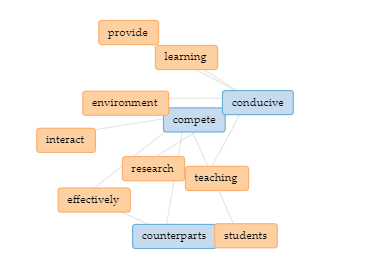
Exhibit 9: Link among the keywords in the University of Lagos’ Vision Statement
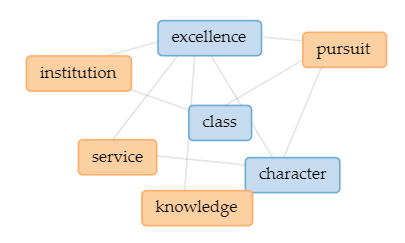
Obafemi Awolowo University is another University established in the same year of founding the University of Lagos. The University intends, its mission, “to nurture a teaching and learning community; advance frontiers of knowledge; engender a sense of selfless public service; and add value to African culture.” Like the University of Nigeria, the Obafemi Awolowo University wants “to be a top-rated university in Africa,” according to its vision statement. Trending analysis reveals that there is a direct link between the mission and vision of the University. This is obvious when analysis shows that the University wants to add value to African societies and culture through teaching [with the best graduates as resultant output], learning and researching.
Exhibit 10: Link among the keywords in the Obafemi Awolowo University’s Mission Statement
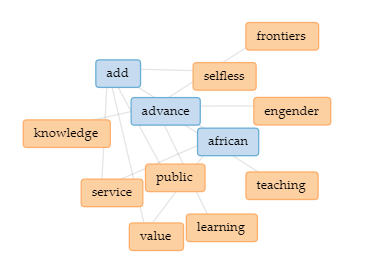
Exhibit 11: Link among the keywords in the Obafemi Awolowo University’s Vision Statement
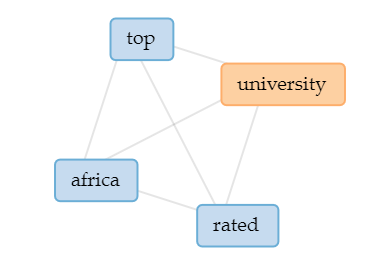
Ahmadu Bello University is the third University that shares same year of establishment with the University of Lagos. It was established in 1962. It is a University that believes in “information not localized” as its core purpose of existence [mission]. Realisation of this according to the University will make it “a world-class university comparable to any other, engaged in imparting contemporary knowledge, using high quality facilities and multi-disciplinary approaches, to men and women of all races, as well as generating new ideas and intellectual practices relevant to the needs of its immediate community, Nigeria and the world at large,” [vision].
Based on these statements, trending analysis indicates that the University believes in employing approaches that would enable it to make information at its disposal globalised not localized. This reflects mostly in its use of “Ahmadu Bello, university and world” frequently in the vision statement. However, the mission statement of the University needs further analysis. This is essential because of the need to ascertain what the University has done in terms of globalizing its research outputs not only producing graduates who are contributing to societal growth in all ramifications.
Exhibit 12: Link among the keywords in the Ahmadu Bello University’s Mission Statement
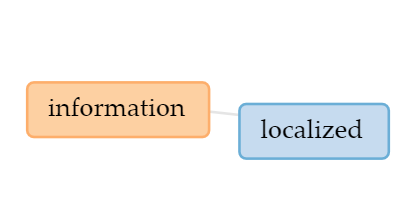
Exhibit 13: Link among the keywords in the Ahmadu Bello University’s Vision Statement
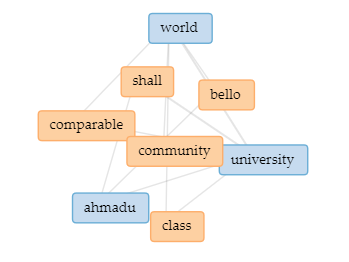
University of Benin is one of the Universities established in 1970s. It actually came into existence in 1970. Make its contribution to the Nigerian society and global community, the University intends “to develop the human mind to be creative, innovative, competent in areas of specialization, knowledgeable in entrepreneurship and dedicated to service,” [mission]. Actualisation of these will enable the University “to establish a model institution of higher learning which ranks among the best in the world and responsive to the creative and innovative abilities of the Nigerian people,” [vision]. In trending analysis of both statements, we discovered that the University tends towards deploying and applying its resources in areas that would elevate it and its products [graduates and research outputs].
Exhibit 14: Link among the keywords in the University of Benin’s Mission Statement
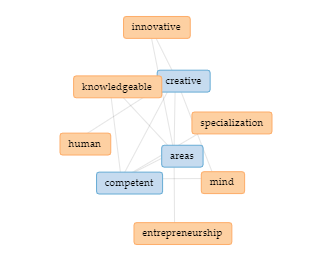
Exhibit 15: Link among the keywords in the University of Benin’s Vision Statement
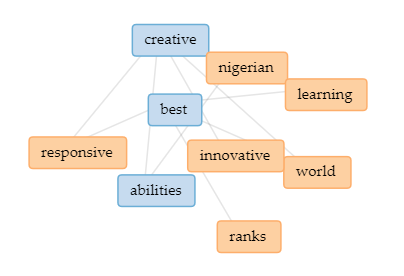
University of Ilorin was established in 1975 with the intent of “providing world-class environment for learning, research and community service,” [mission] and “be an international center of excellence in learning, research, probity and service to humanity.” From these statements, it is clear that the University wants to be known as the University that produces best graduates for the Nigerian and global society having deployed the right methodologies in a conducive environment for teaching, learning and researching.
Exhibit 16: Link among the keywords in the University of Ilorin’s Mission Statement
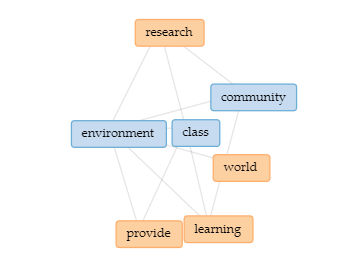
Exhibit 17: Link among the keywords in the University of Ilorin’s Vision Statement
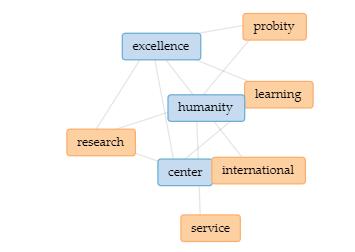
In 1975, the University of Calabar was founded. Our check reveals that the University intends “to produce high quality graduates and scholars in focal areas of learning with theoretical, practical and entrepreneurial skills for the world of work in conducive environment through quality research and teaching.” [mission]. In addition, it wants to be seen as “a centre of excellence producing globally competitive graduates and contributing significantly to development through research,” [vision].
Like other Universities that prefer to be known as Universities which ensure conducive academic environment, the University of Calabar also believes in the strategic statement mantra, our analysis reveals. It believes in having a better environment for the production graduates who are not only competent in administrative and management task execution but also entrepreneurial in thinking after graduation. In its vision, the University believes in gaining competitive advantage through its competencies and being rated as the best centre for higher education acquisition and contributor to the societal growth and development.
Exhibit 18: Link among the keywords in the University of Calabar’s Mission Statement
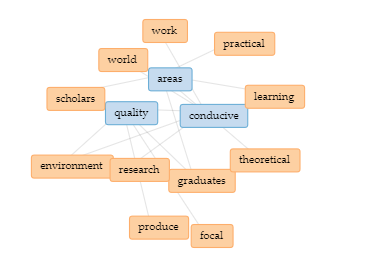
Exhibit 19: Link among the keywords in the University of Calabar’s Vision Statement
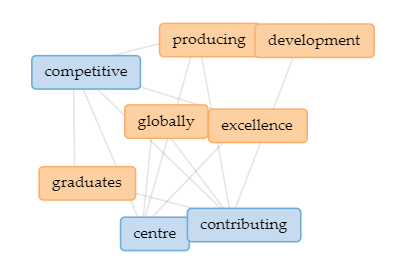
University of Maiduguri was also established in 1975. According to our checks, this is the only oldest University has more words in mission and vision statements. The mission of the University includes “the University of Maiduguri shall be an institution dedicated to scholarship and learning in the arts, sciences, humanities and technology, and the development of moral and civic character of all persons who pass through her portals. The University shall facilitate and advance scholarship and learning, especially in the light of her location in the Sahelian environment in the North-Eastern Nigeria, and at the cross-roads of Africa and Middle-Eastern culture.”
The vision includes; the University of Maiduguri apart from achieving competence in the basic arts and sciences, aims at excellence in agriculture, pastoralism, engineering, human and veterinary medicine and information technology as well as in arid zone, trans-Saharan and inter-African peace and strategic studies. The University also aims to promote the development of private and public morality, discipline, accountability and probity, and also international cooperation through participation, research and dissemination of information.”
Our trending analysis shows that the University of Maiduguri is the only oldest University that stressed Easternalisation of its products [especially graduates]. By Easternalisation, we mean that the University focuses more on solving manpower problems in the North-Eastern region of Nigeria. It is also only University that emphasises accountability through participation, research and dissemination of information.
Exhibit 20: Link among the keywords in the University of Maiduguri’s Mission Statement
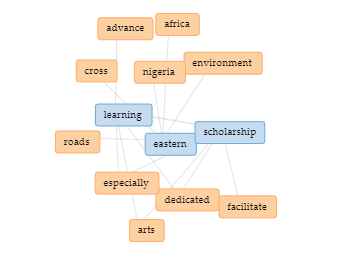
Exhibit 21: Link among the keywords in the University of Maiduguri’s Vision Statement
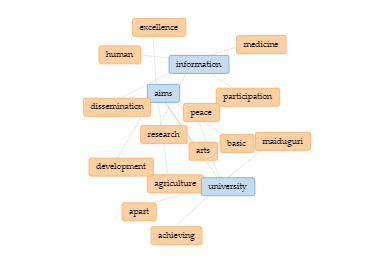
Strategic Options
From the insights, it is clear that the oldest Universities need to reconstruct their mission and vision statements to conform with the current national and global needs. It is good that trends in vision statements tend towards global influence and push for research and teaching, but is also necessary that the Universities quantify their vision statements.
Absence of quantitative elements such as the range of scores/rating positions to be accomplished within research, teaching, innovation among other indicators shows a significant void which must be filled. The Universities that lack inclusion of historical and cultural backgrounds as well as political and economic conditions of the country should consider the inclusion. This is decisive in understanding country’s ideologies and predicting its future growth and development through the Universities’ contributions.



